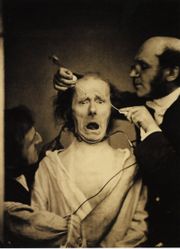Guillaume Duchenne
Guillaume Duchenne: The Father of Electrotherapy and Neuropathology
<pageby comments="false" nominor="false"></pageby>;
The search for ways to use electricity for medical treatment is well rooted in history. Peter Christian Abildgaard suggested the possibilities in a bizarre way in 1775, when he discovered that he could render a chicken unconscious with an electric shock, and then revive it the same way. In 1780, Luigi Galvani noticed that his static-electricity generator caused the muscles in a frog’s leg to contract. And between the late 1700s and early 1840s, when it first became known that each beat of the heart was accompanied by an electrical pulse, there was an explosion of interest in using electricity either to study or cure the body.
One of the key researchers during this period was French physician Guillaume Duchenne (1806-1875). Beginning in the 1840s, Duchenne used either batteries or Michael Faraday’s recently invented induction coil to apply currents to make muscles twitch, mapping the paths the current took through the body. As he learned more about the body, he found ways to apply the electrodes to isolate certain muscles. Conducting extensive experiments on the hands, feet and arms, he carefully mapped the muscles that cause smiles, frowns, looks of anxiety and other facial expressions. He also made limited progress using “faradic” (ac) currents to treat paralysis, finding that by applying high currents, certain patients could regain use of their muscles
Duchenne also employed the relatively new technology of photography to document his results, using a variety of subjects including actors, children and Parisian indigents. He published a book of his findings in 1862 that remained a standard text for many years.
Remembered as the father of electrotherapy and neuropathology, Duchenne’s name is memorialized in the disease Duchenne Muscular Dystrophy, one of the debilitating diseases that he hoped electrical stimulation might alleviate. But Duchenne’s work was little appreciated at the time. When he died in 1875, the direct use of electricity for questionable medical purposes (rather than simply studying its effects on the body) was reaching its height. For the next 75 years, machines using “faradic” or “galvanic” (dc) electricity would remain in widespread use. Although few of these devices produced reliable results, it would be many decades before physicians were finally convinced that electrotherapy had only a very limited value in clinical medicine. Eventually, however, the findings of the early pioneers such as Duchenne helped establish the basis for clinical neurology and paved the way for more sophisticated treatment methods.
Further Reading
<rating comment="false"> Well Written? 1 (No) 2 3 4 5 (Yes) </rating> <rating comment="false"> Informative? 1 (No) 2 3 4 5 (Yes) </rating> <rating comment="false"> Accurate? 1 (No) 2 3 4 5 (Yes) </rating>
